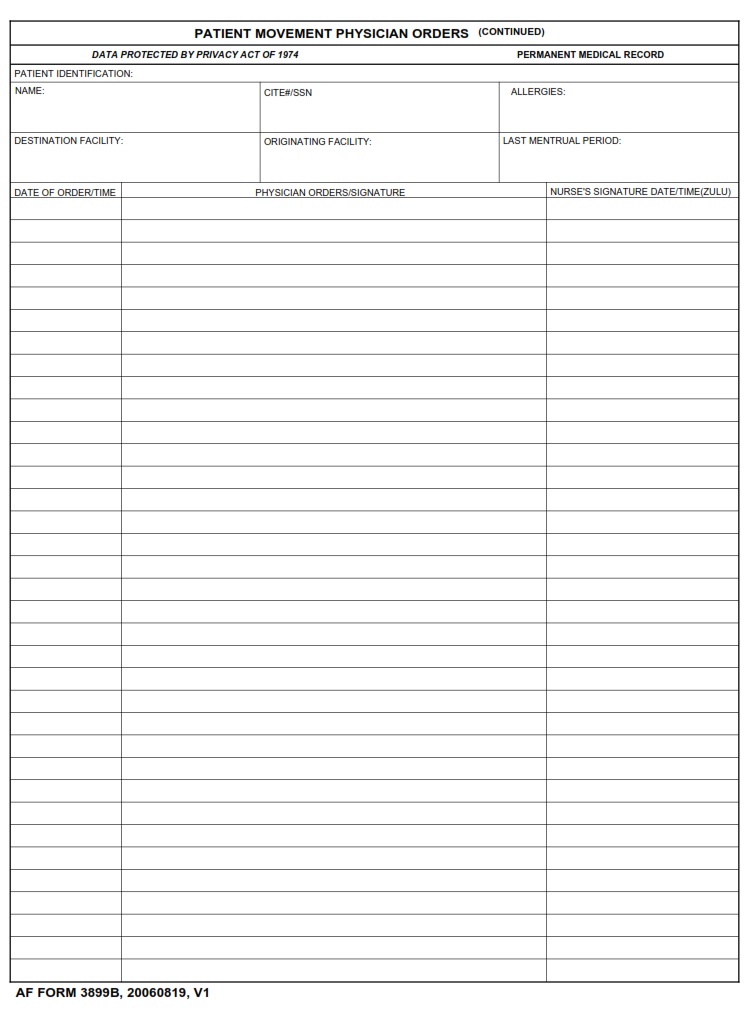AF-FORMS.COM – AF Form 3899B – Patient Movement Physician Orders – Have you ever wondered how military personnel are transported during medical emergencies? Well, let me introduce you to a crucial document that plays a significant role in patient movement within the United States Air Force. The AF Form 3899B – Patient Movement Physician Orders is not just any ordinary piece of paper; it holds the power to save lives by ensuring seamless and efficient transportation of patients. In this article, we will delve into the details of this essential form, exploring its purpose, components, and the critical role it plays in military healthcare.
Picture this: An urgent medical situation arises on an Air Force base, requiring immediate evacuation of a patient to receive specialized treatment elsewhere. Chaos ensues as time becomes of the essence and decisions need to be made swiftly. In moments like these, a seemingly unassuming document called the AF Form 3899B – Patient Movement Physician Orders emerges as a true hero. This form acts as a guiding light for medical professionals, outlining vital information regarding patient transport and shaping critical decisions that can mean the difference between life and death. Join us as we unravel the secrets behind this remarkable document and discover how it ensures timely care for those who serve our country.
Download AF Form 3899B – Patient Movement Physician Orders
| Form Number | AF Form 3899B |
| Form Title | Patient Movement Physician Orders |
| Edition Date | 8/19/2006 |
| File Size | 28 KB |
AF-Form-3899B-Patient-Movement-Physician-Orders.pdf (54 downloads )
What is an AF Form 3899B?
AF Form 3899B, also known as Patient Movement Physician Orders, is a vital document used by the United States Air Force for the efficient and safe transportation of patients. This form plays a crucial role in coordinating medical transportation, ensuring that patients receive appropriate care while being moved from one location to another. It contains essential information such as patient demographics, medical conditions, required medical interventions during transit, and any special considerations or precautions.
One unique aspect of AF Form 3899B is its emphasis on standardization and clarity. The form provides a structured format that enables healthcare providers to communicate key information accurately and concisely. This ensures consistency in understanding among all members involved in patient movement, including physicians, nurses, paramedics, and logistics personnel. As a result, potential errors or misunderstandings are minimized, leading to smoother transitions between medical facilities and ultimately better patient outcomes.
Furthermore, AF Form 3899B highlights the Air Force’s commitment to prioritizing patient safety during transit. By including specific instructions regarding medical treatments necessary during transport (such as oxygen administration or medication administration), this form serves as an important tool for healthcare professionals to anticipate potential risks and provide appropriate care while en route. This proactive approach not only enhances the quality of care but also helps prevent adverse events that could compromise a patient’s health during transportation.
In conclusion, AF Form 3899B serves as an indispensable tool for effective communication and coordination within the United States Air Force’s patient movement system.
Where Can I Find an AF Form 3899B?
If you’re searching for an AF Form 3899B, also known as the Patient Movement Physician Order, there are several places where you can find this crucial form. Firstly, the online portal of the United States Air Force is a great starting point. They have a comprehensive collection of official forms that can be downloaded and printed for free. Additionally, most military healthcare facilities will have physical copies of AF Form 3899B readily available for use.
For those who prefer a more convenient approach, various third-party websites also offer downloadable versions of AF Form 3899B. These sites often provide other related resources and information alongside the form itself so that users can gain a deeper understanding of its purpose and correct usage.
Lastly, it’s worth mentioning that reaching out to medical personnel within your own unit or organization might be an easy solution as well. They will likely have access to AF Form 3899B and can assist in providing you with a copy or guiding you to the appropriate channels to obtain one.
In summary, finding an AF Form 3899B is not an arduous task thanks to several options available at your disposal – from official military websites to third-party platforms and knowledgeable medical professionals. So whether you’re working on patient movement orders or simply seeking more information about this form, rest assured that accessing it should be relatively seamless.
AF Form 3899B – Patient Movement Physician Orders
AF Form 3899B, also known as the Patient Movement Physician Orders (PMPO) form, plays a crucial role in ensuring the efficient and safe transport of patients within the military healthcare system. This form serves as a vital communication tool between physicians, medical personnel, and transportation providers. It provides detailed instructions on how to properly transfer patients from one location to another while considering their medical needs.
One of the key aspects of AF Form 3899B is its ability to document any special requirements or considerations for patient movement. For instance, if a patient requires specific medical equipment during transport or has unique conditions that need attention en route, such as maintaining a stable temperature or oxygen supply – all of these essential details are documented on this form. By doing so, it ensures that every member involved in transporting the patient is aware of their specific needs and can make necessary arrangements accordingly.
Furthermore, the PMPO form facilitates effective communication between different health facilities involved in transferring patients. The clear documentation it provides helps prevent any miscommunication or information gaps during patient handoff, particularly when multiple care teams are responsible for different stages of transportation. This thorough documentation helps establish accountability and promotes continuity of care throughout the entire journey – ultimately increasing patient safety and ensuring seamless transitions during transfers.
